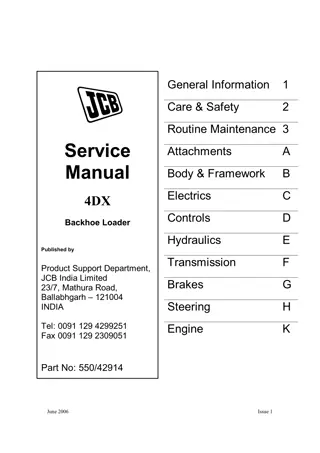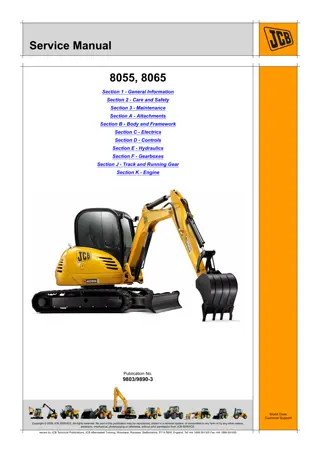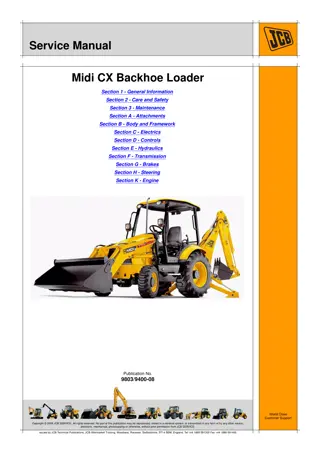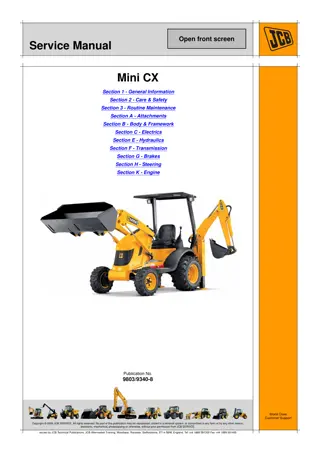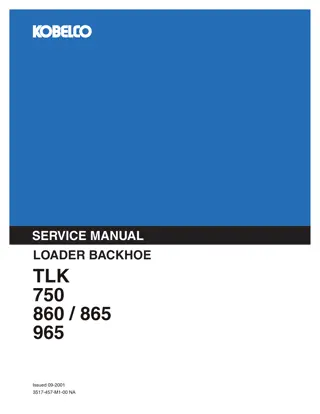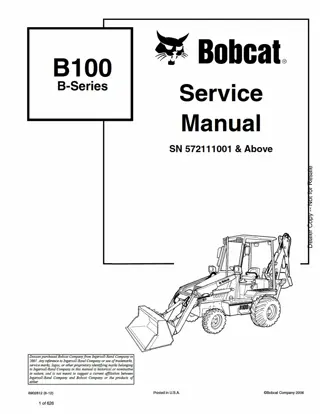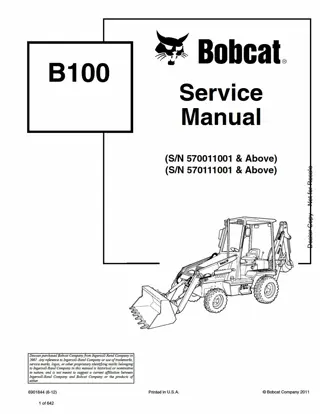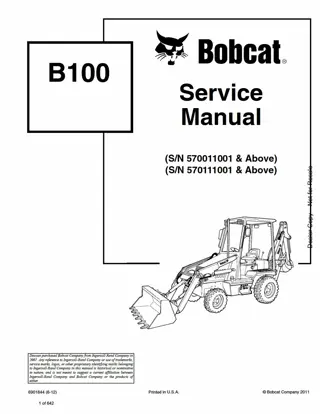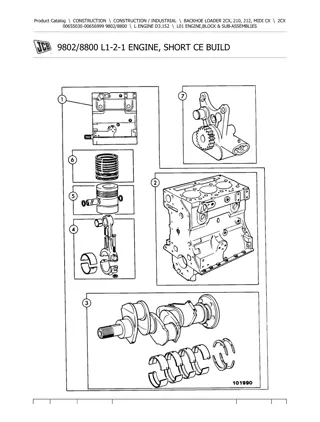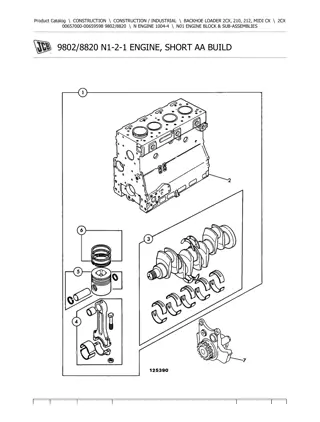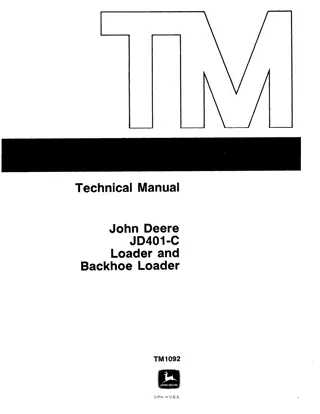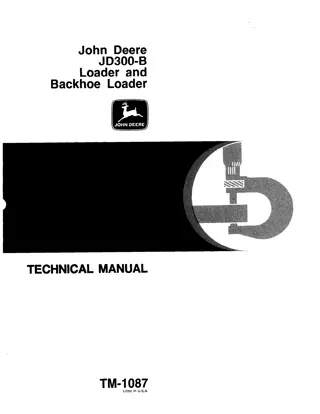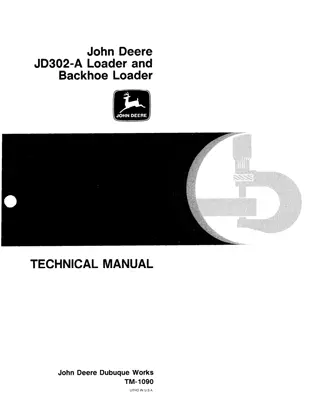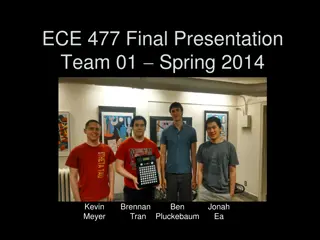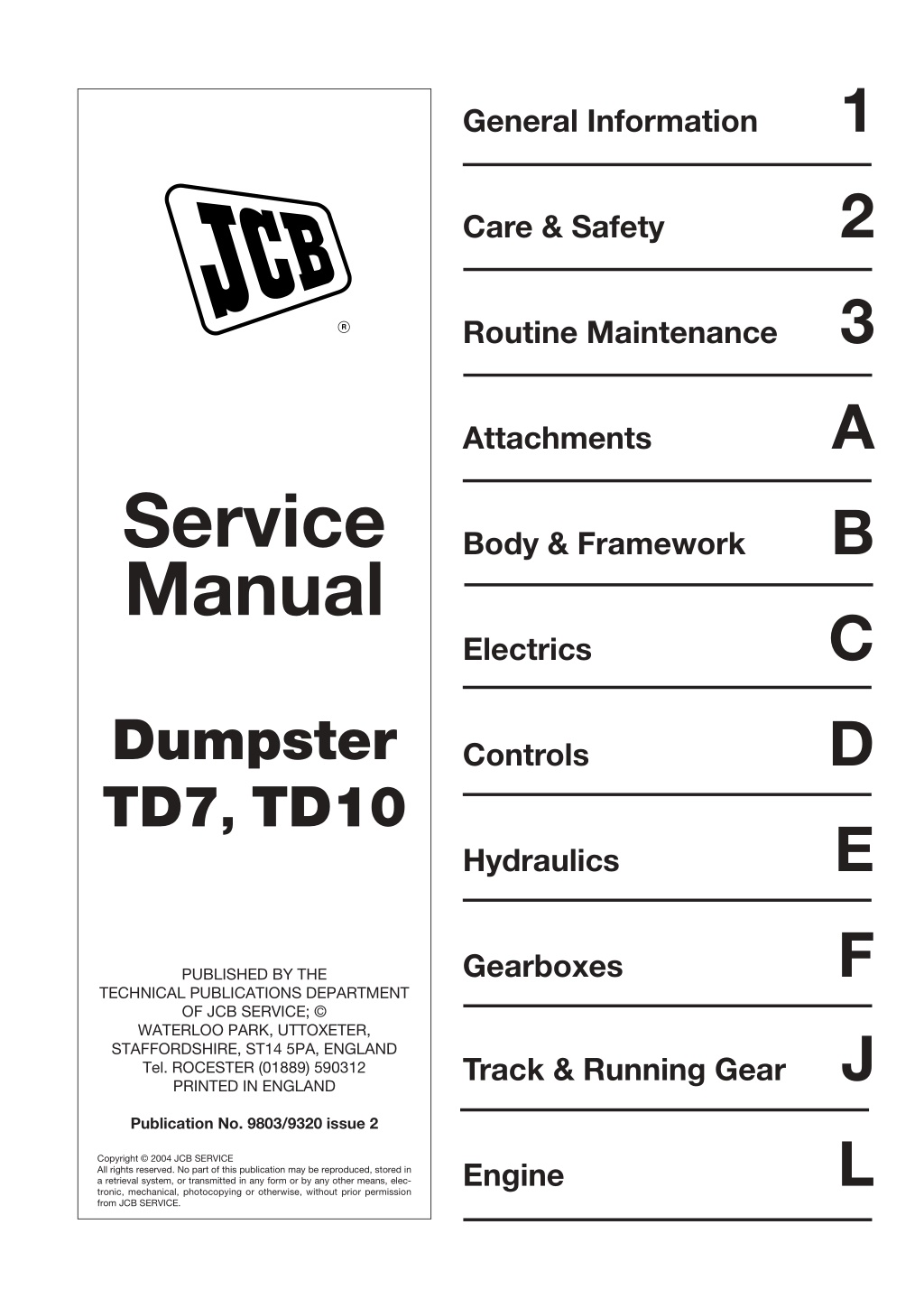
JCB MIDI CX BACKHOE LOADER Service Repair Manual Instant Download 1
Please open the website below to get the complete manualnn//
Download Presentation

Please find below an Image/Link to download the presentation.
The content on the website is provided AS IS for your information and personal use only. It may not be sold, licensed, or shared on other websites without obtaining consent from the author. Download presentation by click this link. If you encounter any issues during the download, it is possible that the publisher has removed the file from their server.
E N D
Presentation Transcript
1 General Information 2 Care & Safety 3 Routine Maintenance R A Attachments Service Manual B Body & Framework C Electrics D Dumpster TD7, TD10 Controls E Hydraulics F Gearboxes PUBLISHED BY THE TECHNICAL PUBLICATIONS DEPARTMENT OF JCB SERVICE; WATERLOO PARK, UTTOXETER, STAFFORDSHIRE, ST14 5PA, ENGLAND Tel. ROCESTER (01889) 590312 PRINTED IN ENGLAND Track & Running Gear J Publication No. 9803/9320 issue 2 L Copyright 2004 JCB SERVICE All rights reserved. No part of this publication may be reproduced, stored in a retrieval system, or transmitted in any form or by any other means, elec- tronic, mechanical, photocopying or otherwise, without prior permission from JCB SERVICE. Engine
Introduction This publication is designed for the benefit of J CB Distributor Service Engineers who are receiving, or have received, training by J CB Technical Training Department. These personnel should have a sound knowledge of workshop practice, safety procedures, and general techniques associated with the maintenance and repair of hydraulic earthmoving equipment. Renewal of oil seals, gaskets, etc., and any component showing obvious signs of wear or damage is expected as a matter of course. It is expected that components will be cleaned and lubricated where appropriate, and that any opened hose or pipe connections will be blanked to prevent excessive loss of hydraulic fluid and ingress of dirt. Finally, please remember above all else SAFETY MUST COME FIRST! The manual is compiled in sections, the first three are numbered and contain information as follows: 1 2 3 = = = General Information - includes machine operating procedures. Care & Safety - includes warnings and cautions pertinent to aspects of workshop procedures etc. Routine Maintenance - includes service schedules, procedures, torque settings and recommended lubricants. The remaining sections are alphabetically coded and deal with Dismantling, Overhaul etc. of specific components, for example: A B = = Attachments Body & Framework ...etc The page numbering in each alphabetically coded section is not continuous. This allows for the insertion of new items in later issues of the manual. Section contents, technical data, circuit descriptions, operation descriptions etc. are inserted at the beginning of each alphabetically coded section. All sections are listed on the front cover; tabbed divider cards align directly with individual sections on the front cover for rapid reference. Where a torque setting is given as a single figure it may be varied by plus or minus 3%. Torque figures indicated are for dry threads, hence for lubricated threads may be reduced by one third. Left Hand and Right Hand are as viewed from the rear of the machine facing forwards. 9803/9320 Issue 1
General Information Section 1 Section 1 i i Contents Page No. Introduction 1 - 1 Walk Round Inspection 1 - 1 Identifying the Machine 1 - 2 Engine and Track Controls Track Controls Before starting the engine Starting the engine Stopping the engine 2 - 1 2 - 2 2 - 3 2 - 4 2 - 5 Refuelling the machine 3 - 1 Using Attachments and Site Safety Working on slopes 4 - 1 4 - 2 Getting the machine moving 5 - 1 TD7/TD10 Operating the hydraulic dumper skip Uninstalling the dumper skip Installing the dumper skip 6 - 1 6 - 2 6 - 3 Shovel Loader Installing the shovel loader Connecting to the hydraulic system Using the shovel loader 7 - 1 7 - 2 7 - 3 7 - 3 * High Lift Shovel Loader Using the high lift Using the high lift warning device Extending the undercarriage 8 - 1 8 - 1 8 - 1 8 - 2 Transporting the machine 9 - 1 Storage/Preparation 10 - 1 Troubleshooting 11 - 1 9803/9320 Issue 2*
https://www.ebooklibonline.com Hello dear friend! Thank you very much for reading. Enter the link into your browser. The full manual is available for immediate download. https://www.ebooklibonline.com
Section 1 General Information Section 1 Introduction 1 - 1 1 - 1 This chapter is arranged to guide you step-by-step through the task of learning how to use the machine. Read it through from beginning to end. By the end of the chapter you should have a good understanding of the machine and how to operate it. Move on to the attachment controls only when you can drive the machine confidently and safely. Take great care when practising with the attachment controls. Practise in an open space, keep people clear. Do not jerk the controls: operate them slowly until you understand the effect they have on the machine. Pay particular attention to all safety messages. They are there to warn you of possible hazards. Do not just read them - think about what they mean. Understand the hazards and how to avoid them. Finally, do not rush the job of learning. Take your time and take it safely. If there is anything you do not understand, ask your J CB dealer, he will be pleased to advise you. Remember BE CAREFUL BE ALERT BE SAFE When you have learned where the driving controls are and what they do, practise using them. Practise driving the machine in a safe, open space clear of other people. Get to know the "feel" of the machine and its driving controls. Walk Round Inspection !WARNING The following checks should be made each time you return to the machine after leaving it for any period of time. We advise you also to stop the machine occasionally during long work sessions and do the checks again. You could be killed or injured with damaged tracks. Do not use the machine with damaged or excessively worn tracks. HOP27 All these checks concern the serviceability of the machine. Some concern your safety. Get your service engineer to check and correct any defects. 3 Check the Tracks (Rubber) Check for cut rubber and penetration by sharp objects. Do not use a machine with damaged tracks. Machine Walk Round Inspection 4 Check the fuel filler cap Make sure the fuel filler cap is tightly closed. 1 Check for cleanliness: a Remove dirt and debris, especially from around the engine, skip rams and tracks. b Make sure the footplate and handrails are clean and dry. 2 Check for damage: a Inspect the machine generally for damaged and missing parts. b Check for oil and fuel leakages beneath the machine. 9803/9320 Issue 1
General Information Section 1 Section 1 Identifying the Machine 1 - 2 1 - 2 The machine has a Data Plate A attached to the left hand face of the machine, above the engine. On TD10 machines from serial no. 1011234 the Data Plate is fitted to the rear face of the engine cover, as shown at B. * The serial numbers of the machine are stamped on this plate. A The engine serial number is stamped on the engine. OSEN ISO9001 J C BAMFORD EXCAVATORS LTD ROCESTER, STAFFS FM 14063 Product Identification Number VIN Vehicle Identification Number ENGINE SERIAL NUMBER LH TRACK GEARBOX SERIAL RH TRACK GEARBOX SERIAL WEIGHT kg ENGINE POWER kW @ RPM YEAR OF MANUFACTURE H04344 B T000100 9803/9320 Issue 2*
General Information Section 1 Section 1 Engine and Track Controls 2 - 1 2 - 1 Controls * * Standard undercarriage Variable width undercarriage DE C D C E A A G B B F F 768570 402271 A B C D E F Left track control lever Skip control lever Right track control lever 2 speed control lever Accessory hydraulic control lever Remote throttle lever A B C D E F G Left track control lever Skip control lever Right track control lever 2 speed control lever Accessory hydraulic control lever Remote throttle lever Track extension Track Controls The two tracks are controlled by a pair of control levers A and C. Each lever controls one track and is spring loaded to the central position. In this position the track does not operate. The left side lever controls the left track. The right side lever controls the right track. The two levers can be operated individually or together as necessary to move the machine as required. D A C An increase in speed can be achieved by operating the two speed tracking lever D. Use this higher speed only on smooth level ground. !WARNING Do not operate the controls from the side of the machine. When operating the machine, stand behind the controls at all times. 402271 * Note: Illustration shows standard undercarriage controls. 9803/9320 Issue 2*
General Information Section 1 Section 1 Engine and Track Controls - continued 2 - 2 2 - 2 A B 422422 422431 C 422441 !WARNING Forward (A) To move the machine forward, push both levers forward. Release the levers to stop. The slower the track controls are moved to full travel, the more progressive the starting of the machine movement will be. Always stop the machine and drop the engine speed to idle before changing from forward to reverse or from reverse to forward. * Do not operate the controls from the side of the machine, when operating the machine, stand behind the controls at all times. !WARNING Make sure that all persons are clear before moving. !WARNING Reverse (A) To move the machine backward, pull both levers backward. Release the levers to stop. Low speed must always be selected when unloading the machine from a vehicle or tracking down steep slopes. The machine will stop/start more abruptly when the levers are operated if high speed is selected. 0076 Turn (B) To turn the machine whilst travelling, move the lever back towards the central position on the side towards which you want to go e.g. move the left lever back to turn left. This causes the left track to move slower than the other. The faster moving right track will push the machine around. !WARNING Ear Defenders * In continuous 8-hour operation the average operator noise exposure from this machine can exceed 85 dB(A). In these circumstances ear plugs or noise defenders must be worn. If you do not wear ear plugs or noise defenders your hearing may be permanently damaged. The 8-hour averaged threshold of 85 dB(A) might not be reached if use of the machine is less than 8-hours and the noise exposure from other sources in the remaining period is less than 85 dB(A). An assessment of daily noise exposure should be undertaken to determine if hearing protection is required. Spin (C) To spin the machine around through 360 , without moving it, operate one lever in a forward position and the other in a reverse position. This will cause the tracks to drive in opposite directions and hence push the machine around. It is recommended that low speed is selected when spin turning. 9803/9320 Issue 2*
General Information Section 1 Section 1 Engine and Track Controls - continued 2 - 3 2 - 3 Before starting the engine !CAUTION Always carry out an inspection before starting the engine. This could prevent an accident or equipment damage. Refuel in a well ventilated area with the engine stopped. Petrol is highly flammable and explosive under certain conditions. Do not overfill the fuel tank. There should be no fuel in the filler neck. Make sure the filler cap is tightly closed. To prevent fire hazards and to provide adequate ventilation, the engine should be 1 metre away from buildings and other equipment. Exhaust gases contain carbon monoxide. Avoid inhalation of exhaust gases. Never run the engine in a close, confined area. Do not place flammable items such as petrol, matches etc. close to the engine when it is running. C B A 403151 9803/9320 Issue 2
General Information Section 1 Section 1 Engine and Track Controls - continued 2 - 4 2 - 4 Engine Starting procedure - Electric start model 1 Turn the fuel valve A to the ON position. 2 Move the choke lever B to the CLOSED position. Note: It may not be necessary to use the choke if the engine is warm or the air temperature is high. Move the choke lever to a position to suit the prevailing conditions. 3 Open the remote throttle lever slightly. 4 Turn the ignition switch to the START position and hold until the engine starts. Note: Do not hold the ignition switch in the START position for more than 5 seconds. If the engine fails to start, release the switch and wait 10 seconds before operating the starter again. 5 When the engine starts, return the switch to the ON (middle) position. 6 As the engine warms up, gradually move the choke control to the fully OPEN position for normal working. Note: On TD10 machines from serial no. 1011234 access to the fuel valve and choke is through aperture C in the engine cover. * Engine Starting procedure - Manual start model. 1 Turn the fuel valve A to the ON position. 2 Move the throttle lever B to the CLOSED position. Note: It may not be necessary to use the choke if the engine is warm or the air temperature is high. Move the choke lever to a position to suit the prevailing conditions. 3 Open the remote throttle slightly. 4 Pull the starter grip lightly until you feel resistance, then pull briskly. Return the starter grip gently. 5 As the engine warms up, gradually move the choke control to the fully OPEN position for normal working. 9803/9320 Issue 2*
General Information Section 1 Section 1 Engine and Track Controls - continued 2 - 5 2 - 5 Stopping the engine Electric start model A 1 Move the remote throttle lever A back to the idle position. 2 Turn the ignition switch to the OFF position. 402271 3 Move the fuel valve to the OFF position. Emergency engine stop To stop the engine quickly, turn the ignition switch to OFF. 402791 OFF OFF Stopping the engine Manual start model 1 Move the remote throttle lever A back to the idle position. 2 Turn the switch to the OFF position. 3 Move the fuel valve to the OFF position. Emergence engine stop 417251 To stop the engine quickly, turn the fuel valve to OFF. 402791 OFF OFF 9803/9320 Issue 2
Section 1 General Information Section 1 Refuelling the Machine 3 - 1 3 - 1 Before refuelling the machine, make sure you use the correct fuel for the engine. Use unleaded petrol with an octane rating of 86 or higher. 1 Remove the fuel filler cap. 2 Carefully fill with fuel to below the filler neck. !WARNING 3 Refit the fuel filler cap and ensure that the cap vent is clear. Petrol is extremely flammable and is explosive under certain conditions. Refuel in a well ventilated area with the engine stopped. Do not smoke or allow flames or sparks in the area of refuelling. Do not overfill the fuel tank. There should be no fuel in the filler neck. Make sure that the filler cap is correctly and securely fitted. Be careful not to spill fuel when refuelling. Spilled fuel or fuel vapour may ignite. If any fuel is spilt, make sure the area is dry before starting the engine. 9803/9320 Issue 1
Section 1 General Information Section 1 Using Attachments and Site Safety 4 - 1 4 - 1 !WARNING General site safety This section explains some techniques for efficient and safe use of the machine and its attachments. Attention is also drawn to the various safety aspects of operating on site. Read and understand this section before you start working with the machine. Practice using the attachments until you are completely familiar with the controls and what they do. Before you start using this machine, inspect the job site. You could be killed or injured if the ground gives way under your machine or if piled material collapses onto it. Check for potholes and hidden debris, logs, ironwork etc. Any of these could cause you to lose control of your machine. HOP52 !CAUTION Legal liability You and/or your company could be legally liable for any damage you cause to public utilities. Make sure that you know the locations of all public utility cables or pipes on the site which could be damaged by your machine. HOP53 !WARNING If you will be working with a labourer, make sure that you both understand what each other will be doing. Learn and use the recognised signalling procedures. Do not rely on shouting; he will not hear you! HOP58 Before you start using the machine, tell your workmates what you will be doing and where you will be working. Remember that your machine is mobile. Whenever possible, manoeuvre your machine into a position which combines safety with efficiency. If you have to chose remember that SAFETY MUST COME FIRST! !WARNING Reworking old sites There could be hazardous materials such as asbestos, poisonous chemicals or other harmful substances buried on the site. If you uncover any containers or if you see any signs of toxic waste, stop the machine and inform the site manager immediately. !WARNING Do not use the machine on platforms, scaffolding or ramps. The machine must not be operated on scaffolding/temporary structures or platforms. Do not use the machine on make-shift ramps. 9803/9320 Issue 1
Section 1 General Information Section 1 Using Attachments and Site Safety - continued 4 - 2 4 - 2 Working on Slopes Try to avoid moving across slopes. Even on slopes of less than 10 there is a greater danger of the machine sliding if the ground surface is loose or wet. !WARNING A dumper skip full of material will raise the machines centre of gravity and increase the possibility of the machine tipping over on a slope. !WARNING Failure to observe these precautions may cause the machine to become unstable and in extreme circumstances will overturn with potential serious injury to the operator. HOP64 !WARNING Hill sides If repeated journeys across a slope are unavoidable, cut a level platform for the machine to travel on to increase stability. Operating on hillsides can be hazardous, especially moving across a slope. If the slope is too steep, your machine could roll over. Remember that loose surface material and mud will change the ground conditions. In any event do not drive across a slope of greater than 15 . HOP60-1 Do not attempt climb up a slope greater than 15 . Before attempting to travel up a slope make sure that the engine and hydraulic fluid have reached working temperature. !WARNING Do not make sudden direction changes when moving up a slope. Always chock the rear of the tracks if you stop on a slope, even for a short while. Do not ride on the footplate when moving on a slope, as it will change the centre of gravity and increase the possibility of the machine tipping over. When travelling down a slope, engage low speed gear only. 15 10 9803/9320 Issue 1
General Information Section 1 Section 1 Getting the Machine Moving 5 - 1 5 - 1 After you have warmed up the engine, move off as described below. Read the following Operating Warnings first. !WARNING Do not stand on the footplate without an onboard attachment secured to the machine. This will unbalance the machine and could result in the machine tipping backwards. !WARNING * Do not operate the controls from the side of the machine, when operating the machine, stand behind the controls at all times. The machine does not have gears. Do not overwork the engine unnecessarily. Operate at an engine speed suitable for the duty being carried out. When moving the machine, keep it under control at all times. Stay alert for obstructions and possible hazards. Approach soft or muddy ground slowly. !WARNING You and others could be killed or injured if you reverse direction on the move, because the change in direction will be sudden and without warning to others. When working in confined spaces, be aware of crush potential to the operator and others. Always stop the machine and drop engine speed to idle before changing from forward to reverse or vice versa. HOP51 !WARNING Ear Defenders * In continuous 8-hour operation the average operator noise exposure from this machine can exceed 85 dB(A). In these circumstances ear plugs or noise defenders must be worn. If you do not wear ear plugs or noise defenders your hearing may be permanently damaged. The 8-hour averaged threshold of 85 dB(A) might not be reached if use of the machine is less than 8-hours and the noise exposure from other sources in the remaining period is less than 85 dB(A). An assessment of daily noise exposure should be undertaken to determine if hearing protection is required. 9803/9320 Issue 2*
Section 1 General Information Section 1 6 - 1 6 - 1 TD7/TD10 !WARNING Operating the hydraulic skip When working on the machine under a raised skip, make sure that the tipper control lever cannot be operated and that a ram strut is in place. Moving the tipping lever forwards hydraulically raises the rear of the skip to release the load. Controlled dumping can be achieved by progressively moving the lever forward a little and returning it to the neutral position. Moving the tipping lever back returns the skip to the horizontal (rest) position ready for loading. 402271 9803/9320 Issue 1
General Information Section 1 Section 1 TD7/TD10 - continued 6 - 2 6 - 2 Disconnecting the skip A Raise the skip to the tip position and fit a ram stay at A. Stop the engine Disconnect the hydraulic hoses from the skip using the quick connections B on the hydraulic ram. B Fit the two supports into the special slots making sure they do not foul the release system. Unscrew bolt A and drive the machine slowly backwards from the quick release system B until support C can be installed. !WARNING Do not stand on the footplate without an onboard attachment secured to the machine. This will unbalance the machine and result in the machine tipping backwards. B A Do not stand on the footplate when a load is being tipped as this will change the centre of gravity and unbalance the machine. !WARNING * Do not operate the controls from the side of the machine, when operating the machine, stand behind the controls at all times. When all three supports are in place, reverse the machine clear of the skip. C 9803/9320 Issue 2*
General Information Section 1 Section 1 TD7/TD10 - continued 6 - 3 6 - 3 Installing the skip !WARNING Do not stand on the footplate without an onboard attachment secured to the machine. This will unbalance the machine and result in the machine tipping backwards. !WARNING * Do not operate the controls from the side of the machine, when operating the machine, stand behind the controls at all times. C Position the skip on firm level ground on its three supports. Slowly drive the machine into the quick release slides until support C can be removed. Continue forward until the skip can be secured to the machine with bolt A. D Connect the hydraulic hoses to the quick connections and remove the ram strut. Lower the skip and remove front supports D The kit has two fixed reference pins E to ensure correct and easy fixing to the undercarriage. E 9803/9320 Issue 2*
Section 1 General Information Section 1 Shovel Loader 7 - 1 7 - 1 B C A D E A B C D E Skip Shovel Shovel arm Storage stand slots Shovel rams 9803/9320 Issue 1
Suggest: If the above button click is invalid. Please download this document first, and then click the above link to download the complete manual. Thank you so much for reading
General Information Section 1 Section 1 Shovel Loader - continued 7 - 2 7 - 2 Installing the shovel loader !WARNING Do not stand on the footplate without an onboard attachment secured to the machine. This will unbalance the machine and result in the machine tipping backwards. !WARNING * A Do not operate the controls from the side of the machine, when operating the machine, stand behind the controls at all times. Swing and secure the footplate in the upright position. Start the engine and slowly move the machine forward behind the skip and into the quick release guides, until support A can be removed. Continue forward to the end of the guides and secure the skip/shovel loader to the machine with the nuts B. B B 9803/9320 Issue 2*
https://www.ebooklibonline.com Hello dear friend! Thank you very much for reading. Enter the link into your browser. The full manual is available for immediate download. https://www.ebooklibonline.com

